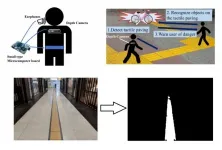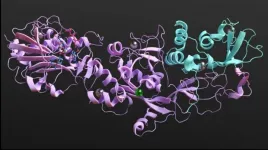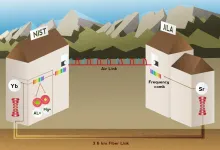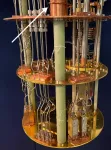INFORMATION:
Approved medications preserve platelets and protect mice from bacterial blood infections
2021-03-24
(Press-News.org) A study of 49 patients reveals that toxins from the bacterial pathogen Staphylococcus aureus can destroy the body's blood-clotting platelets, raising the risk of death during bacterial blood infections. Further experiments in mice also showed that the approved drugs ticagrelor and oseltamivir protected platelets and helped treat infections, suggesting these compounds could be repurposed into badly needed therapies for blood infections. Bacterial blood infections have mortality rates as high as 20% to 30% even with supportive care, and these rates have remained high for decades. Blood infections can also cause complications such as sepsis and endocarditis, and the rise of multidrug resistance has only compounded what was already a serious threat to public health. Infections with S. aureus are particularly difficult to treat, as the bacteria possess a range of tricks and defense mechanisms that allow them to evade or resist immune cells and antibiotics. While studying 49 patients with S. aureus blood infections, Josh Sun and colleagues discovered that many patients who succumbed showed abnormally low counts of platelets - small blood-clotting cells that can also combat infections. Follow-up experiments showed that S. aureus targeted platelets by secreting a toxin that destroyed platelet proteins, and by accelerating the clearance of platelets through the Ashwell-Morell receptor on liver cells. However, the approved blood thinner ticagrelor and the flu antiviral oseltamivir both protected platelets from the toxin-induced clearance in mice with S. aureus blood infections and improved survival. Sun et al. speculate that these drugs, if repurposed, could be combined with platelet infusions to further restore and protect platelet counts in ailing patients.
ELSE PRESS RELEASES FROM THIS DATE:
Exploiting cancer cells to aid in their own destruction
2021-03-24
Immunotherapy, which recruits the body's own immune system to attack cancer, has given many cancer patients a new avenue to treat the disease.
But many cancer immunotherapy treatments can be expensive, have devastating side effects, and only work in a fraction of patients.
Researchers at the Pritzker School of Molecular Engineering at the University of Chicago have developed a new therapeutic vaccine that uses a patient's own tumor cells to train their immune system to find and kill cancer.
The vaccine, which is injected into the skin just like a traditional vaccine, stopped melanoma tumor growth in mouse models. It even worked long-term, destroying new tumors long after the therapy was given.
The results were published ...
Green leafy vegetables essential for muscle strength
2021-03-24
Eating just one cup of leafy green vegetables every day could boost muscle function, according to new Edith Cowan University (ECU) research.
The study, published today in the Journal of Nutrition, found that people who consumed a nitrate-rich diet, predominantly from vegetables, had significantly better muscle function of their lower limb.
Poor muscle function is linked to greater risk of falls and fractures and is considered a key indicator of general health and wellbeing.
Researchers examined data from 3,759 Australians taking part in Melbourne's Baker Heart and Diabetes Institute AusDiab study over a 12-year ...
Stay on track! Support system to help the visually impaired navigate tactile paving
2021-03-24
Sight is by far the sense that we humans use the most when navigating an environment. When those who are blind or visually impaired walk alone, they put themselves at great risk of falling or colliding with obstacles, especially when traversing new places. Unfortunately, the number of visually impaired people throughout the world is likely to increase in the near future because of the rapidly aging population. Thus, there is an urgent need for innovative and cost-effective solutions to help visually impaired people navigate safely.
A promising strategy that was first implemented in Japan and then replicated throughout the world is called tactile paving. Inspired by Braille, the reading system of the blind, tactile paving essentially consists of ...
'Silencing' protein to weaken COVID-19
2021-03-24
When invaded by a virus, our body cells launch an alert to neighboring cells to increase their antiviral defenses to prevent the infection from spreading. Some viruses, however, manage to bypass this system by mimicking the host's RNA, preventing them from being detected by the infected cell and avoiding this alert. In the case of SARS-CoV-2, this mimicking uses a protein known as nsp14. This protein is also very important for virus multiplication, a task which is facilitated by its binding to the nsp10 protein, resulting in a protein complex. Interfering with nsp14 binding and with the nsp10-nsp14 protein complex is the aim of the most recent ITQB NOVA research in COVID-19, led by researchers Margarida Saramago, Rute Matos and Cecília Arraiano.
The researchers ...
Photosynthesis could be as old as life itself
2021-03-24
Researchers find that the earliest bacteria had the tools to perform a crucial step in photosynthesis, changing how we think life evolved on Earth.
The finding also challenges expectations for how life might have evolved on other planets. The evolution of photosynthesis that produces oxygen is thought to be the key factor in the eventual emergence of complex life. This was thought to take several billion years to evolve, but if in fact the earliest life could do it, then other planets may have evolved complex life much earlier than previously thought.
The ...
New machine learning tool diagnoses electron beams in an efficient, non-invasive way
2021-03-24
Beams of accelerated electrons power electron microscopes, X-ray lasers, medical accelerators and other devices. To optimize the performance of these applications, operators must be able to analyze the quality of the beams and adjust them as needed.
For the past few years, researchers at the Department of Energy's SLAC National Accelerator Laboratory have been developing "virtual diagnostics" that use machine learning to obtain crucial information about beam quality in an efficient, non-invasive way. Now, a new virtual diagnostic approach, published in Scientific Reports, incorporates additional information about the beam that allows the method to work in situations where conventional ...
Stanford economist and others assess aquaculture's promise and peril
2021-03-24
Despite aquaculture's potential to feed a growing world population while relieving pressure on badly depleted oceans, the industry has been plagued by questions about its environmental impacts. (Watch related video: https://www.youtube.com/watch?v=DG_nl7-naYo)
But over the years, the diverse industry - which ranges from massive open-ocean salmon cages to family farm freshwater tilapia ponds - has made significant strides toward sustainability, according to a new Stanford-led analysis.
The study notes, however, that in order for the global aquaculture sector to deliver on its full promise, more effective oversight measures are ...
NIST team compares 3 top atomic clocks with record accuracy over both fiber and air
2021-03-24
In a significant advance toward the future redefinition of the international unit of time, the second, a research team led by the National Institute of Standards and Technology (NIST) has compared three of the world's leading atomic clocks with record accuracy over both air and optical fiber links.
Described in the March 25 issue of Nature, the NIST-led work is the first to compare three clocks, based on different atoms, and the first to link the most advanced atomic clocks in different locations over the air. These atomic clock comparisons place the scientific community one step closer to meeting the guidelines for redefinition of the second.
"These comparisons are really defining ...
Soils or plants will absorb more CO2 as carbon levels rise - but not both
2021-03-24
Carbon dioxide in the atmosphere fuels plant growth. As carbon levels rise, it's appealing to think of supercharged plant growth and massive tree-planting campaigns drawing down the CO2 produced by fossil fuel burning, agriculture and other human activities.
New research published March 24 in Nature, however, suggests that when elevated carbon dioxide levels drive increased plant growth, it takes a surprisingly steep toll on another big carbon sink: the soil.
One likely explanation, the authors say, is that plants effectively mine the soil for nutrients they need to keep up with carbon-fueled growth. Extracting the extra nutrients requires revving up microbial activity, which then releases CO2 into the atmosphere that might otherwise remain locked in soil.
The findings contradict ...
Optical fiber could boost power of superconducting quantum computers
2021-03-24
The secret to building superconducting quantum computers with massive processing power may be an ordinary telecommunications technology - optical fiber.
Physicists at the National Institute of Standards and Technology (NIST) have measured and controlled a superconducting quantum bit (qubit) using light-conducting fiber instead of metal electrical wires, paving the way to packing a million qubits into a quantum computer rather than just a few thousand. The demonstration is described in the March 25 issue of Nature.
Superconducting circuits are a leading technology for making quantum computers because they are reliable and easily mass produced. But these circuits must operate at cryogenic temperatures, and schemes for wiring them to room-temperature electronics are complex and prone to ...






